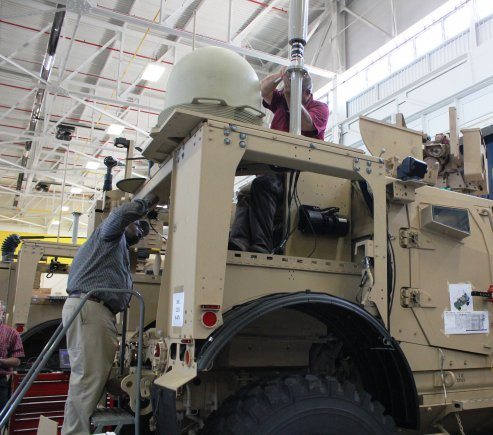To meet the aggressive schedule the Army set for Capability Set 13 fielding, dozens of engineers and support personnel at the U.S. Army Tank Automotive Research, Development and Engineering Center, in Warren, Mich., have spent the last six months immersed in design, integration and production activities on the first five “super configuration” mine-resistant, ambush-protected prototype vehicles equipped with CS 13 assets.
Capability Set 13, or CS 13, validated as part of the Army’s Network Integration Evaluations, known as NIEs, is the Army’s first fully-integrated package of radios, satellite systems, software applications, smartphone-like devices and other network components that provide an integrated connectivity from the static tactical operations center to the commander on-the-move to the dismounted soldier, and will begin fielding in October 2012 to two Brigade Combat Teams, known as BCTs, in the 10th Mountain Division.
“We’re taking lessons learned from the Network Integration Evaluations down at White Sands (N.M.) and Fort Bliss (Texas) and then bringing them to a production-ready capability here at [U.S. Army Tank Automotive Research, Development and Engineering Center],” said Brig Gen. Dan Hughes, director, SoSI. “All of the design and engineering work is done here and proven out here before we go down range with these capabilities.”
U.S. Army Tank Automotive Research, Development and Engineering Center, or TARDEC, with support from the Red River Army Depot, Program Manager MRAP, the Communication and Electronics Research, Development and Engineering Center, known as CERDEC, and the System of Systems Integration, or SoSI, Directorate, completed the design, integration and production of the five prototype vehicles in a mere six months–reducing the normal prototyping time line by six-eight months in order to meet the aggressive schedule the Army set for CS 13 fielding.
“In order to quickly get these much needed capabilities to our deployed forces, we’re working outside of the box in many ways,” said Luis Hinojosa, acting director, Center for Ground Vehicle Development & Integration, U.S. Army RDECOM-TARDEC. “This is not a prototype approach. In order to get a production-ready deliverable, we’re working vehicle design and prototype integration in parallel with production at [Space and Naval Warfare Systems Command] and doing it in less than half the time than would typically be allotted for this scope of work.”
The five “super configuration” mine-resistant, ambush-protected, or MRAP, configurations prototyped at TARDEC include MRAP All-Terrain Vehicle, or M-ATV, Soldier Network Extension, M-ATV Point of Presence, M-ATV Vehicular Wireless Package, M-ATV-Lite and MRAP MaxxPro Dash.
The vehicles are equipped with the latest Army tactical radios, mission command software and the Warfighter Information Network-Tactical satellite communications suite. These vehicles will provide soldiers and commanders with mobile networking, or mission command on the move, allowing them to take valuable network capability with them as they maneuver around the battlefield.
“The five prototype vehicles are currently being shipped from TARDEC to Aberdeen Proving Ground (Md.) for antennae testing, network testing and safety certification,” said Hughes. “[Army Test and Evaluation Command] will go through and do safety testing to make sure it’s safe for Soldiers to be inside the vehicle. They look at electric, mechanical, fires safety and the vehicle itself.”
Based on that safety certification, the remaining MRAP production assets to support the October fielding CS 13 are currently being integrated and produced at the Space and Naval Warfare Systems Command, or SPAWAR, in Charleston, S.C., with some being shipped to APG throughout August and September for safety release/network verification testing prior to arriving in at 10th Mountain Division in October.
“We incorporated lessons learned from the NIEs that allowed us to streamline engineering, prototyping and production build designs near simultaneously,” said Paul Wilson, director of Synchronized Fielding, SoSI. “A more traditional approach doesn’t follow this sort of process since they do not have the advantage of the processor data from the Agile Process, but the total Army team effort between Research and Development Centers, production facilities and the program managers allows us to meet new equipment training schedules with multiple vehicle deliveries to 10th Mountain Division starting in October.”
CS 13 will field to eight Infantry BCTs, with priority to units deploying or preparing to deploy to Operation Enduring Freedom and a forward stationed brigade in Korea, from 2012 to 2013. The 3rd and 4th BCTs of the 10th Mountain Division will begin new equipment training in October 2012, prior to deploying with CS 13 in 2013.










